-
 Bitcoin
Bitcoin $106,754.6083
1.33% -
 Ethereum
Ethereum $2,625.8249
3.80% -
 Tether USDt
Tether USDt $1.0001
-0.03% -
 XRP
XRP $2.1891
1.67% -
 BNB
BNB $654.5220
0.66% -
 Solana
Solana $156.9428
7.28% -
 USDC
USDC $0.9998
0.00% -
 Dogecoin
Dogecoin $0.1780
1.14% -
 TRON
TRON $0.2706
-0.16% -
 Cardano
Cardano $0.6470
2.77% -
 Hyperliquid
Hyperliquid $44.6467
10.24% -
 Sui
Sui $3.1128
3.86% -
 Bitcoin Cash
Bitcoin Cash $455.7646
3.00% -
 Chainlink
Chainlink $13.6858
4.08% -
 UNUS SED LEO
UNUS SED LEO $9.2682
0.21% -
 Avalanche
Avalanche $19.7433
3.79% -
 Stellar
Stellar $0.2616
1.64% -
 Toncoin
Toncoin $3.0222
2.19% -
 Shiba Inu
Shiba Inu $0.0...01220
1.49% -
 Hedera
Hedera $0.1580
2.75% -
 Litecoin
Litecoin $87.4964
2.29% -
 Polkadot
Polkadot $3.8958
3.05% -
 Ethena USDe
Ethena USDe $1.0000
-0.04% -
 Monero
Monero $317.2263
0.26% -
 Bitget Token
Bitget Token $4.5985
1.68% -
 Dai
Dai $0.9999
0.00% -
 Pepe
Pepe $0.0...01140
2.44% -
 Uniswap
Uniswap $7.6065
5.29% -
 Pi
Pi $0.6042
-2.00% -
 Aave
Aave $289.6343
6.02%
How to operate after the EMV indicator crosses the zero axis and then steps back to confirm?
The EMV indicator's zero line crossover, combined with a step-back confirmation, helps traders identify potential trends in cryptocurrencies like Bitcoin and Ethereum.
Jun 15, 2025 at 09:14 am
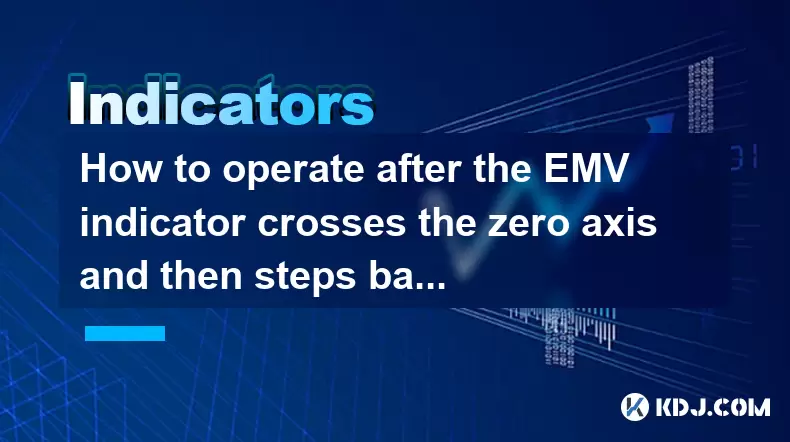
Understanding the EMV Indicator and Its Zero Line Crossover
The Ease of Movement (EMV) indicator is a technical analysis tool used by traders to assess the relationship between volume and price change. It helps identify whether a cryptocurrency is being accumulated or distributed. When the EMV crosses above the zero line, it suggests that buying pressure is increasing, while a cross below indicates growing selling pressure. However, a single crossover does not always confirm a trend reversal; many experienced traders wait for a step-back confirmation before entering a trade.
This article will guide you through how to operate after the EMV indicator crosses the zero axis and then steps back to confirm, particularly within the context of trading cryptocurrencies like Bitcoin, Ethereum, and altcoins.
Identifying the Initial EMV Cross Over Zero
Before considering any action, it's essential to first recognize when the EMV line crosses the zero axis. In most charting platforms, such as TradingView or Binance’s native tools, the EMV is plotted in a sub-window below the price chart.
- If the EMV rises from negative territory and moves above zero, this may signal bullish momentum.
- Conversely, if the EMV drops below zero from positive territory, it could indicate bearish pressure.
It's crucial to note that false signals can occur, especially during sideways or low-volume market conditions. Therefore, traders should not act solely on the initial crossover but instead look for additional confirmation via a step-back.
Waiting for the Step-Back Confirmation
Once the EMV has crossed the zero line, the next critical step is to observe whether it pulls back toward the zero line again without crossing back over. This step-back acts as a confirmation signal that the new trend may be sustainable.
Here’s how to monitor the step-back:
- Observe the EMV line retreating slightly after the initial crossover.
- The EMV should not close significantly below (or above, depending on direction) the zero line.
- During this step-back phase, check for stable or increasing volume, which supports the potential trend continuation.
If the EMV holds near the zero line and begins to move back in the original direction, it confirms that the trend initiated by the crossover still has strength.
Entering the Trade Based on EMV Step-Back Confirmation
After confirming the step-back, traders can consider initiating a position. Here’s a breakdown of how to proceed:
- Enter a long position when the EMV crosses above zero and then retests the zero level from above without breaking below it.
- Enter a short position when the EMV crosses below zero and then retests the zero level from below without breaking above it.
- Place a stop-loss just beyond the recent swing high or low to manage risk effectively.
- Consider using candlestick patterns at the time of step-back for added precision.
Do not rush into a trade immediately after the step-back. Wait for the next candle to confirm that the EMV is indeed resuming its original trajectory post-pullback.
Setting Profit Targets and Managing Risk
Risk management is a vital component of any trading strategy involving indicators like EMV. After entering a trade based on the EMV step-back method, define your profit-taking levels and stop-loss zones clearly.
- Use previous resistance or support levels as potential take-profit points.
- Alternatively, trail your stop-loss behind the moving average or recent price lows/highs.
- Adjust your position size according to your overall portfolio allocation and risk tolerance.
Proper risk-to-reward ratios should be maintained, ideally aiming for at least 1:2 or better. This ensures that even if some trades fail, the winning ones compensate adequately.
Integrating EMV with Other Indicators for Better Accuracy
While the EMV step-back method can be effective on its own, combining it with other tools enhances its reliability. Popular complementary indicators include:
- Moving Averages: Use the 50-period and 200-period moving averages to gauge the broader trend.
- Volume Indicators: Confirm the EMV’s movement with on-balance volume (OBV) or Chaikin Money Flow (CMF).
- RSI or MACD: These help avoid overbought or oversold traps and offer divergence signals.
Using multiple confirmations increases the probability of successful trades, especially in volatile crypto markets where false breakouts are common.
Frequently Asked Questions
What timeframes work best with the EMV step-back strategy?
The EMV step-back strategy performs well on medium-term timeframes like 1-hour or 4-hour charts. Shorter timeframes may generate too many false signals, while longer timeframes might delay entry opportunities.
Can I use EMV step-back in both bull and bear markets?
Yes, the EMV step-back method is applicable in both rising and falling markets. In a bull market, focus on entries after EMV crosses above zero and steps back. In a bear market, look for entries when EMV dips below zero and retraces before continuing downward.
How do I adjust the EMV settings for different cryptocurrencies?
Default EMV settings usually work well across assets, but you can fine-tune them based on volatility. For highly volatile altcoins, consider increasing the period setting to smooth out noise. For more responsive readings in major coins like BTC or ETH, keep the default settings.
Should I ignore EMV signals during consolidation phases?
Yes, during consolidation or sideways price action, EMV can produce misleading signals. Wait for clear breakout patterns or volume surges before acting on EMV crossovers or step-backs during such phases.
Disclaimer:info@kdj.com
The information provided is not trading advice. kdj.com does not assume any responsibility for any investments made based on the information provided in this article. Cryptocurrencies are highly volatile and it is highly recommended that you invest with caution after thorough research!
If you believe that the content used on this website infringes your copyright, please contact us immediately (info@kdj.com) and we will delete it promptly.
- 2025-W Uncirculated American Gold Eagle and Dr. Vera Rubin Quarter Mark New Products
- 2025-06-13 06:25:13
- Ruvi AI (RVU) Leverages Blockchain and Artificial Intelligence to Disrupt Marketing, Entertainment, and Finance
- 2025-06-13 07:05:12
- H100 Group AB Raises 101 Million SEK (Approximately $10.6 Million) to Bolster Bitcoin Reserves
- 2025-06-13 06:25:13
- Galaxy Digital CEO Mike Novogratz Says Bitcoin Will Replace Gold and Go to $1,000,000
- 2025-06-13 06:45:13
- Trust Wallet Token (TWT) Price Drops 5.7% as RWA Integration Plans Ignite Excitement
- 2025-06-13 06:45:13
- Ethereum (ETH) Is in the Second Phase of a Three-Stage Market Cycle
- 2025-06-13 07:25:13
Related knowledge
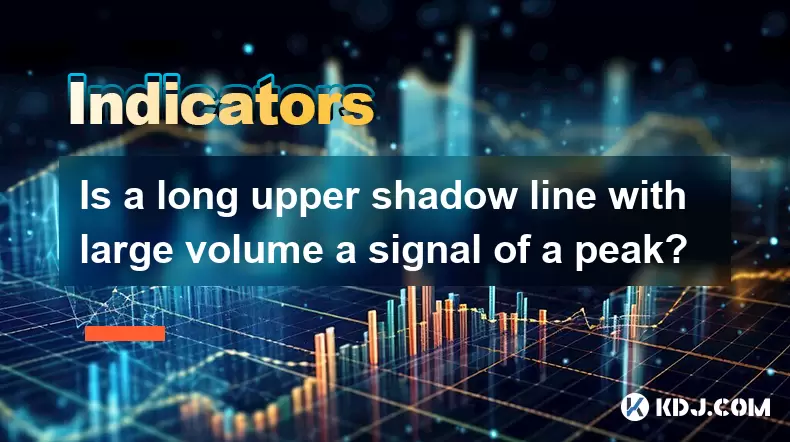
Is a long upper shadow line with large volume a signal of a peak?
Jun 17,2025 at 05:07am
Understanding the Long Upper Shadow LineA long upper shadow line, often referred to as a shooting star or inverted hammer depending on its location in a chart, is a candlestick pattern that indicates potential reversal from an uptrend. This pattern forms when prices rise significantly during the trading period but then fall back to close near the openin...

How to confirm the effectiveness of the average price line support in the time-sharing chart?
Jun 17,2025 at 12:56am
Understanding the Time-Sharing Chart and Its RelevanceIn cryptocurrency trading, time-sharing charts play a crucial role in analyzing short-term price movements. These charts typically display price fluctuations over a specific period, often ranging from minutes to hours. Traders rely on them to make quick decisions based on real-time data. The average ...
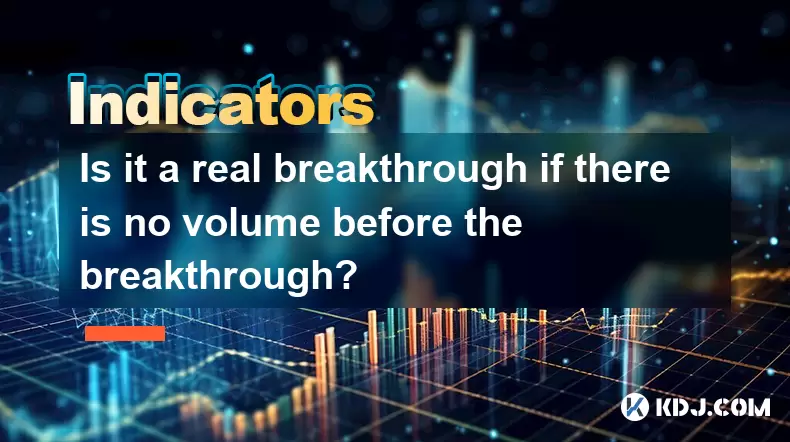
Is it a real breakthrough if there is no volume before the breakthrough?
Jun 17,2025 at 08:03am
Understanding the Concept of a Breakthrough in Cryptocurrency TradingIn cryptocurrency trading, a breakthrough typically refers to a price movement that surpasses a key resistance or support level. Traders often look for such events as potential signals for trend continuation or reversal. However, a crucial factor that determines the strength and reliab...

What does it mean when the momentum indicator breaks above the zero axis?
Jun 17,2025 at 12:43am
Understanding the Momentum IndicatorThe momentum indicator is a technical analysis tool used to measure the speed or velocity of price movements in cryptocurrency markets. It helps traders identify potential trend reversals, overbought or oversold conditions, and confirms existing trends. The indicator typically oscillates around a zero line, with value...
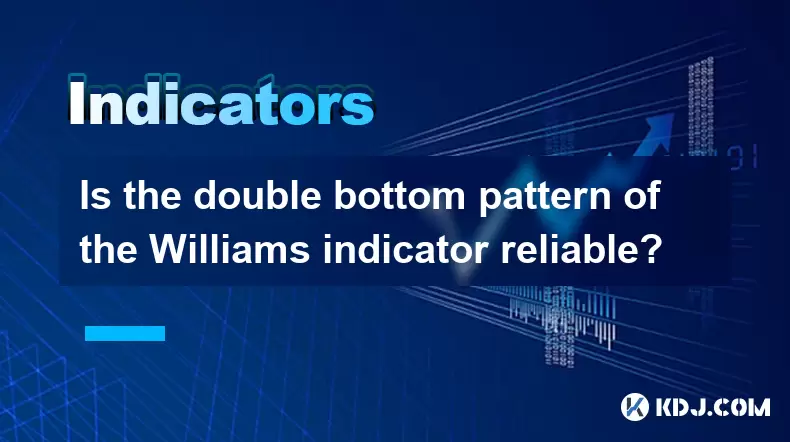
Is the double bottom pattern of the Williams indicator reliable?
Jun 17,2025 at 03:56am
Understanding the Williams Indicator and Its SignificanceThe Williams %R indicator, often referred to as Williams Percent Range, is a momentum oscillator used in technical analysis to identify overbought or oversold conditions in the market. Developed by Larry Williams, this indicator fluctuates between 0 and -100, with readings above -20 indicating ove...
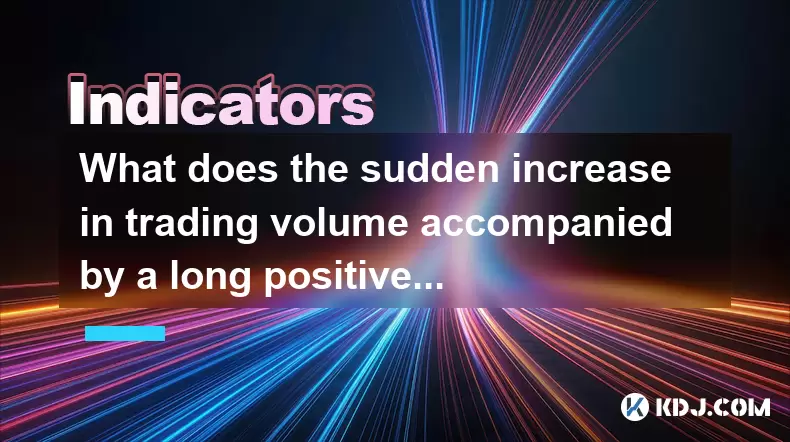
What does the sudden increase in trading volume accompanied by a long positive line mean?
Jun 17,2025 at 06:01am
Understanding the Sudden Surge in Trading VolumeWhen traders observe a sudden increase in trading volume, it typically signals a significant shift in market sentiment. This surge often indicates that more participants are entering or exiting positions, which could be due to news events, macroeconomic data releases, or institutional activity. High tradin...

Is a long upper shadow line with large volume a signal of a peak?
Jun 17,2025 at 05:07am
Understanding the Long Upper Shadow LineA long upper shadow line, often referred to as a shooting star or inverted hammer depending on its location in a chart, is a candlestick pattern that indicates potential reversal from an uptrend. This pattern forms when prices rise significantly during the trading period but then fall back to close near the openin...

How to confirm the effectiveness of the average price line support in the time-sharing chart?
Jun 17,2025 at 12:56am
Understanding the Time-Sharing Chart and Its RelevanceIn cryptocurrency trading, time-sharing charts play a crucial role in analyzing short-term price movements. These charts typically display price fluctuations over a specific period, often ranging from minutes to hours. Traders rely on them to make quick decisions based on real-time data. The average ...

Is it a real breakthrough if there is no volume before the breakthrough?
Jun 17,2025 at 08:03am
Understanding the Concept of a Breakthrough in Cryptocurrency TradingIn cryptocurrency trading, a breakthrough typically refers to a price movement that surpasses a key resistance or support level. Traders often look for such events as potential signals for trend continuation or reversal. However, a crucial factor that determines the strength and reliab...

What does it mean when the momentum indicator breaks above the zero axis?
Jun 17,2025 at 12:43am
Understanding the Momentum IndicatorThe momentum indicator is a technical analysis tool used to measure the speed or velocity of price movements in cryptocurrency markets. It helps traders identify potential trend reversals, overbought or oversold conditions, and confirms existing trends. The indicator typically oscillates around a zero line, with value...

Is the double bottom pattern of the Williams indicator reliable?
Jun 17,2025 at 03:56am
Understanding the Williams Indicator and Its SignificanceThe Williams %R indicator, often referred to as Williams Percent Range, is a momentum oscillator used in technical analysis to identify overbought or oversold conditions in the market. Developed by Larry Williams, this indicator fluctuates between 0 and -100, with readings above -20 indicating ove...

What does the sudden increase in trading volume accompanied by a long positive line mean?
Jun 17,2025 at 06:01am
Understanding the Sudden Surge in Trading VolumeWhen traders observe a sudden increase in trading volume, it typically signals a significant shift in market sentiment. This surge often indicates that more participants are entering or exiting positions, which could be due to news events, macroeconomic data releases, or institutional activity. High tradin...
See all articles

























































































